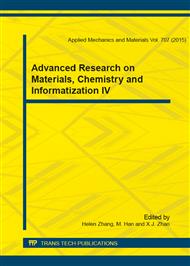p.3
p.7
p.12
p.16
p.20
p.24
p.28
p.32
Determination of N-Heptyl Pyridine Tetrafluoroborate in Acetonitrile Using UV–Spectrum
Abstract:
Ionic Liquids is called also room temperature molten salt, its performance is mainly dependent on composition of cation and anion, and through molecular design the adjustment. And the traditional organic solvent, water, supercritical fluid and chemical reaction than solvent, ionic liquid in the following several aspects to show its prominent advantages. N-heptyl-pyridine tetrafluoroborate is prepared by the double decomposition reaction of HEPB and NaBF4. The ionic liquid at room temperature used in the experiment has a significant absorption determined by UV spectrum within the range of 200-400nm, the maximum absorption wavelength of HEP-BF4 ionic liquid in acetonitrile is 240nm. The standard working curve of HEP-BF4 ionic liquid is y=0.04518+0.03124X (R=0.99963). The linear range of HEP-BF4 ionic liquids in the acetonitrile is 1-75 mg/L. The recovery rate of HEP-BF4 ionic liquid which is between 95.9% and 102%, is measured by standard addition method in acetonitrile.
Info:
Periodical:
Pages:
12-15
Citation:
Online since:
December 2014
Keywords:
Price:
Сopyright:
© 2015 Trans Tech Publications Ltd. All Rights Reserved
Share:
Citation:


